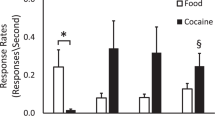Play all audios:

ABSTRACT Neurotensin (NT) is an endogenous brain tridecapeptide that exhibits selective anatomic and neurochemical interactions with rat brain dopaminergic systems. Because modulation of
dopaminergic neurotransmission may underlie many of the behavioral properties of cocaine, the effects of both acute and chronic administration of cocaine on the concentration of NT-like
immunoreactivity (NT-LI) in specific brain regions was determined. Adult male rats were treated with cocaine for 14days at a dose of 40 mg/kg/day (0.118 mmoles/kg/day) administered as either
1 subcutaneous injection per day, or infused continuously using subcutaneously implanted minipumps. Neurotensin-like immunoreactivity in specific brain regions was then measured 24 hours or
8 days following drug administration. After 24 hours of withdrawal from daily subcutaneous injection, the concentration of NT-LI was significantly increased in the substantia nigra (SN) and
frontal cortex. After 24 hours of withdrawal from continuous infusion with cocaine, NT-LI was increased only in the SN. After 8 days of withdrawal, NT-LI was increased in the SN of rats
treated with daily subcutaneous injections of cocaine, but not in the group treated with continuous infusion. Twenty-four hours following a single acute injection of 40 mg/kg of cocaine,
NT-LI was increased in the SN and nucleus accumbens. These results provide evidence consistent with a neuroanatomically selective involvement of NT systems in the behavioral and/or addictive
properties of cocaine. SIMILAR CONTENT BEING VIEWED BY OTHERS RESIDUAL DEFICITS IN FUNCTIONAL BRAIN ACTIVITY AFTER CHRONIC COCAINE SELF-ADMINISTRATION IN RHESUS MONKEYS Article 12 August
2021 DIFFERENTIAL EFFECTS OF ACUTE AND CHRONIC ANTAGONIST AND AN IRREVERSIBLE ANTAGONIST TREATMENT ON COCAINE SELF-ADMINISTRATION BEHAVIOR IN RATS Article Open access 24 May 2022
PHARMACOKINETICS TRUMPS PHARMACODYNAMICS DURING COCAINE CHOICE: A RECONCILIATION WITH THE DOPAMINE HYPOTHESIS OF ADDICTION Article 30 July 2020 ARTICLE PDF AUTHOR INFORMATION Author notes *
Charles B. Nemeroff M.D., Ph.D. Present address: Department of Psychiatry, Emory University School of Medicine, Atlanta, Georgia AUTHORS AND AFFILIATIONS * From the Departments of Psychiatry
Duke University Medical Center, Durham, North Carolina Scott T. Cain Ph.D., Daniel Griff B.S., Catherine M. Joyner B.S., Everett H. Ellinwood M.D. & Charles B. Nemeroff M.D., Ph.D. *
Pharmacology Duke University Medical Center, Durham, North Carolina Everett H. Ellinwood M.D. & Charles B. Nemeroff M.D., Ph.D. Authors * Scott T. Cain Ph.D. View author publications You
can also search for this author inPubMed Google Scholar * Daniel Griff B.S. View author publications You can also search for this author inPubMed Google Scholar * Catherine M. Joyner B.S.
View author publications You can also search for this author inPubMed Google Scholar * Everett H. Ellinwood M.D. View author publications You can also search for this author inPubMed Google
Scholar * Charles B. Nemeroff M.D., Ph.D. View author publications You can also search for this author inPubMed Google Scholar RIGHTS AND PERMISSIONS Reprints and permissions ABOUT THIS
ARTICLE CITE THIS ARTICLE Cain, S., Griff, D., Joyner, C. _et al._ Chronic Continuous or Intermittent Infusion of Cocaine Differentially Alter the Concentration of Neurotensin-like
Immunoreactivity in Specific Rat Brain Regions. _Neuropsychopharmacol_ 8, 259–265 (1993). https://doi.org/10.1038/npp.1993.29 Download citation * Received: 21 January 1992 * Revised: 21
August 1992 * Accepted: 22 September 1992 * Issue Date: 01 May 1993 * DOI: https://doi.org/10.1038/npp.1993.29 SHARE THIS ARTICLE Anyone you share the following link with will be able to
read this content: Get shareable link Sorry, a shareable link is not currently available for this article. Copy to clipboard Provided by the Springer Nature SharedIt content-sharing
initiative KEYWORDS * Neurotensin * Cocaine * Radioimmunoassay * Substantia nigra * Nucleus accumbens * Frontal cortex
